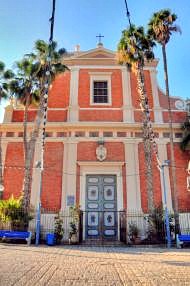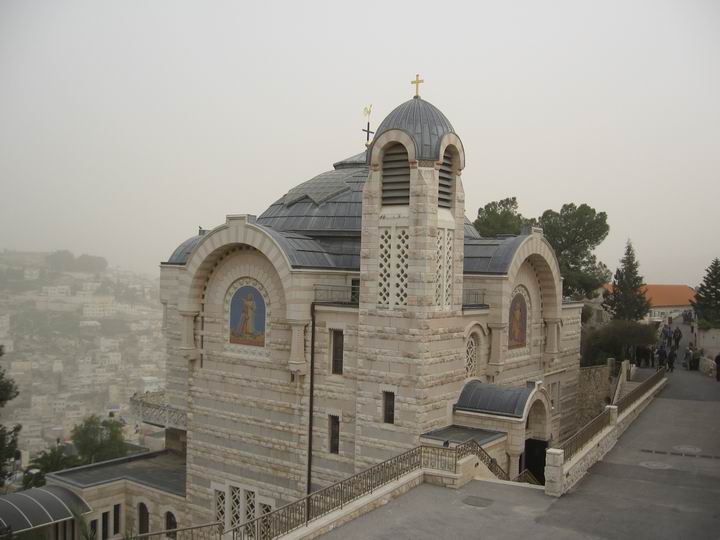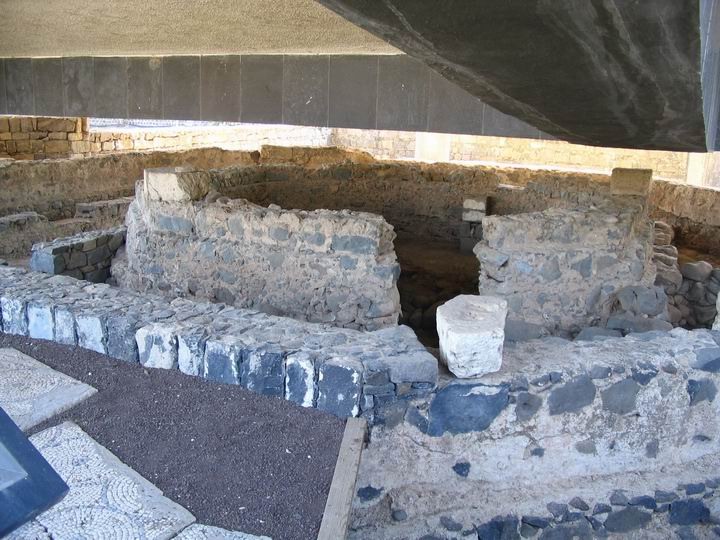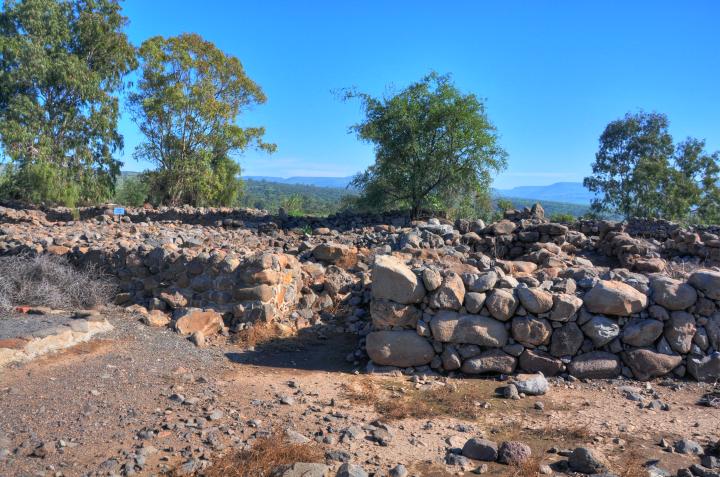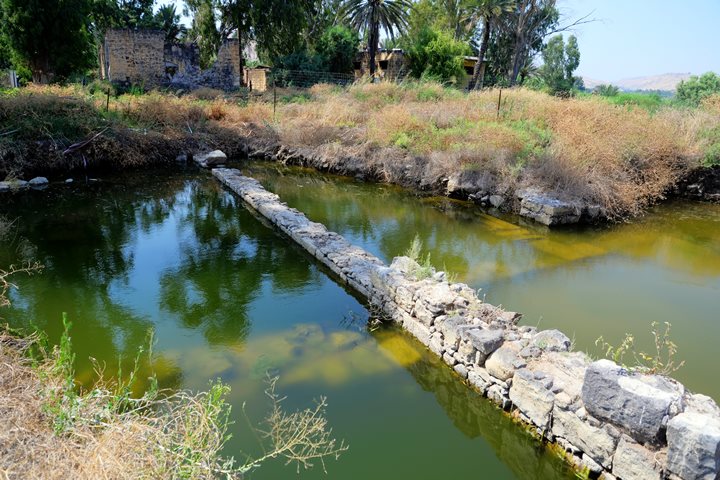Simon Bar-Yonah, later named by Jesus as Peter (Petros, “rock”), was one of the 12 apostles of Jesus. He is regarded as the most important and spokesman of the Apostles, and considered as the first Pope. Matthew 16:18: “upon this rock I will build my church”.
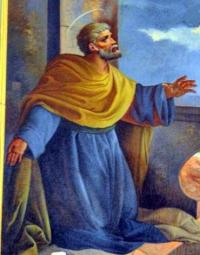
Home > Info > People > St. Peter (the “rock”)
Contents:
Overview
History
Sites of St. Peter
Etymology
Links
Who was St. Peter?
According to the New Testament, Simon/Peter was a fisherman, born in Bethsaida in the north of the Sea of Galilee. This fishermen town was the birthplace of the Apostles Andrew, Peter, and Philip (John 1:44): “Now Philip was of Bethsaida, the city of Andrew and Peter”.
Simon Peter, also known as Saint Peter, was one of the Twelve Apostles of Jesus Christ. He is regarded as the first Pope by the Catholic Church and is considered as one of the most important figures in early Christianity.
According to the New Testament, Peter was a fisherman from Galilee and was called by Jesus to become a disciple. He became one of Jesus’ closest followers and was a witness to many of his miracles and teachings. After Jesus’ death and resurrection, Peter played a prominent role in the early Christian church and was a leader among the apostles.
The New Testament records several instances of Peter’s teachings and actions, and he is also mentioned in other early Christian writings. He is remembered for his impulsive nature and strong faith, as well as for his leadership and teachings. Despite his flaws, Peter is venerated as a saint in many Christian traditions, and his life and teachings continue to inspire Christians today.
History
St. Peter has a prominent place in the Bible, with many references in the Canonical Gospels. The following references are listed in chronological order.
-
Peter joined Jesus as a disciple (Matthew 4 13): “And Jesus, walking by the sea of Galilee, saw two brethren, Simon called Peter, and Andrew his brother, casting a net into the sea: for they were fishers. And he saith unto them, Follow me, and I will make you fishers of men”.
-
Peter’s mother-in-law was healed by Jesus in Capernaum
-
Jesus performed the miracle of the feeding of multitude on Peter’s boat (Luke 5 3): “And he entered into one of the ships, which was Simon’s”
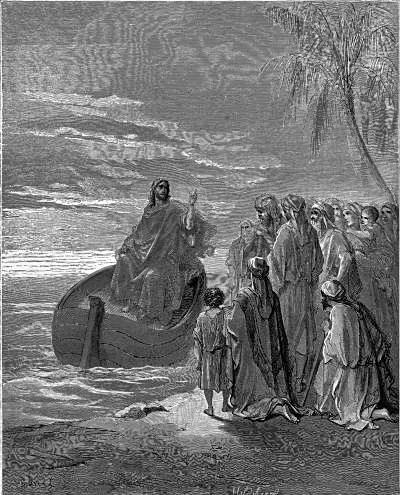
Jesus preaching on the boat of St. Peter
-Drawing by Gustav Dore (French artist, 1832-1883)
-
Jesus transfigured in front of Peter on the high mountain (Matthew 17 1): “And after six days Jesus taketh Peter, James, and John his brother, and bringeth them up into an high mountain apart, And was transfigured before them”
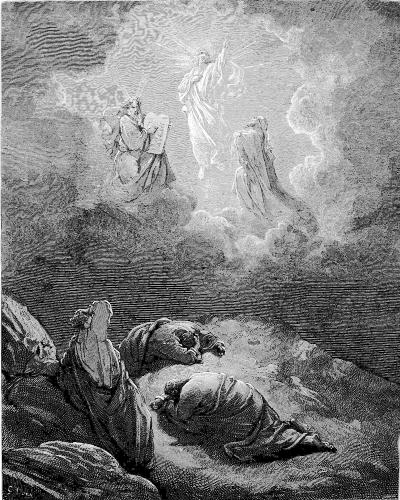
St. Peter with James and John witness the transfiguration
-Drawing by Gustav Dore (French artist, 1832-1883)
-
Peter confessed that Jesus was the Messiah on the trip to Banias (Mark 8 27-29): “And Jesus went out, and his disciples, into the towns of Caesarea Philippi: and by the way he asked his disciples, saying unto them, Whom do men say that I am? … And Peter answereth and saith unto him, Thou art the Christ.
-
Jesus blessed him in turn, giving him the nickname ‘Peter’ – meaning rock (Petros) in Greek (John 1 42): “And he brought him to Jesus. And when Jesus beheld him, he said, Thou art Simon the son of Jona: thou shalt be called Cephas, which is by interpretation, A stone”. Jesus added (Matthew 16:18): “That thou art Peter, and upon this rock I will build my church; and the gates of hell shall not prevail against it”. One interpretation of these words are that Peter will be the founder of the Church, which actually happened years later.
-
Peter reversed his recognition of Jesus, with his triple denial prior to Jesus arrest and trial (Mark 14 29-30): “But Peter said unto him, Although all shall be offended, yet will not I. And Jesus saith unto him, Verily I say unto thee, That this day, even in this night, before the cock crow twice, thou shalt deny me thrice”.
-
Peter witnesses the empty tomb, and was the first to see it according to the Gospel of John (20 1,6) :”Peter therefore went forth, and that other disciple, and came to the sepulchre… and went into the sepulchre, and seeth the linen clothes lie”. After then he left home without notifying the case.
-
Peter reaffirms his love to Jesus in one of the resurrection appearances, and Jesus reconfirm’s that Peter will lead the Church (John 21 17): “…Jesus saith unto him, Feed my sheep”.
Peter leads the early Christian community, as reported by Acts of the Apostles:
-
Delivers an open-air sermon during the Pentecost (Act 2 14): “Peter, standing up with the eleven, lifted up his voice”.
-
Finds a replacement for the dead Apostle, Judas Iscariot (Acts 1 15): “And in those days Peter stood up in the midst of the disciples, and said…”
-
Appears twice before the Sanhedrin (supreme court) defending their acts (Acts 4 8): “Then Peter, filled with the Holy Ghost, said unto them, Ye rulers of the people, and elders of Israel…”; and (Acts 5 29): “Then Peter and the other apostles answered and said, We ought to obey God rather than men…”.
-
Peter was imprisoned by King Herod, but the angle rescued him (Acts 12: 1,5,17): “Now about that time Herod the king stretched forth his hands to vex certain of the church… Peter therefore was kept in prison…And he departed, and went into another place”.
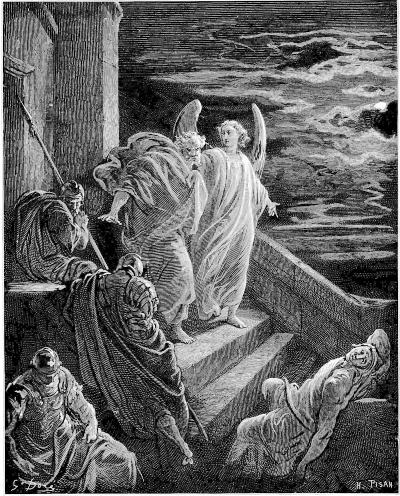
St. Peter freed from prison
-Drawing by Gustav Dore (French artist, 1832-1883)
Peter then travels to Lydda (Lod), Joppa (Jaffa), Caesarea (Maritama) and Antioch on a missionary journey to convert gentiles:
- Lydda: (Acts 9 32): “And it came to pass, as Peter passed throughout all quarters, he came down also to the saints which dwelt at Lydda.”
- Joppa: (Acts 9 36-42): Now there was at Joppa a certain disciple named Tabitha… she was sick, and died… But Peter … presented her alive”.
- Caesarea: (Acts 10 1, 10): “There was a certain man in Caesarea called Cornelius… Peter went up upon the housetop”.
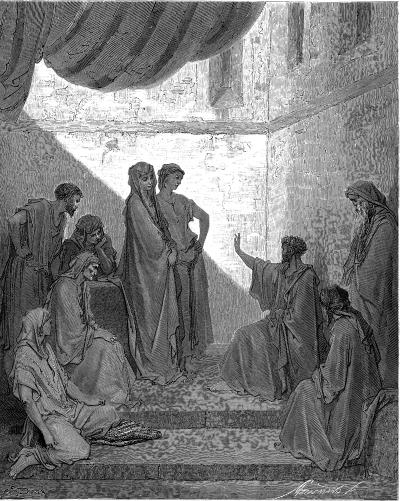
St. Peter in the house of Cornelius (on right, holding his hand)
-Drawing by Gustav Dore (French artist, 1832-1883)
Antioch: He visited Antioch of Syria (Galatians 2:11): “But when Peter was come to Antioch…”.
Thus, Peter was one of the important apostles who was behind of turning the group of followers to the first stage of a newly founded Church. This was exactly as predicted by Jesus (Matthew 16:18): “upon this rock” – meaning Peter – “I will build my church”.
Death in Rome: According to early Christian tradition, Peter was martyred in Rome during the reign of Emperor Nero (c. 64–67 AD). This likely happened near Nero’s Circus on Vatican Hill, a site where Christians were executed after the Great Fire of Rome (64 AD). After Peter’s death, early Christians secretly buried him near the site of his execution, in a cemetery on Vatican Hill (outside Rome’s city walls). A shrine (trophy) was later built over his tomb by Christians in the 2nd century CE to mark the location. Emperor Constantine (4th century AD), after converting to Christianity, ordered the construction of the first St. Peter’s Basilica (c. 326 AD) directly over his tomb.
Sites of St. Peter, featured in BibleWalks:
The following table lists the sites related to St. Peter, which are featured in BibleWalks.com. Click on the site’s name to see more information on each site.
St. Peter’s, Jaffa
- Acts 9 40: “But Peter put them all forth, and kneeled down, and prayed; and turning him to the body said, Tabitha, arise”.
- St. Peter’s is an old Franciscan Church, located in Old Jaffa. It commemorates the visit and miracle of St. Peter in Jaffa.
Click on the photos to enlarge them.
St. Peter in Gallicantu, Mt. Zion, Jerusalem
- Mark 14: 72: “And the second time the cock crew. And Peter called to mind the word that Jesus said unto him, Before the cock crow twice, thou shalt deny me thrice. And when he thought thereon, he wept”.
- The fabulous Saint Peter in-Gallicantu Church is built in the slopes of mount Zion. According to tradition, this was the place of the palace of high priest Caiaphas. Its name is given after the story of Peter’s triple denial of Christ and the cock crowing twice.
Peter’s home in Capernaum
- Matthew 8 14: “And when Jesus was come into Peter’s house, he saw his wife’s mother laid, and sick of a fever”.
- St. Peter was a fisherman, and his house was located close to the shores of the lake. This site is believed to be his house, as verified by the archaeological excavations and the later building of an octagon-shaped church over his house, erected in his honor by the early Christian worshippers.
- Matthew 4 13: “And Jesus, walking by the sea of Galilee, saw two brethren, Simon called Peter, and Andrew his brother, casting a net into the sea: for they were fishers. And he saith unto them, Follow me, and I will make you fishers of men”.
- Peter and his brother Andrew joined Jesus as disciples.
- Acts 9 32: “And it came to pass, as Peter passed throughout all quarters, he came down also to the saints which dwelt at Lydda.”
- Lod/Lydda was one of the ancient cities in the southern coast. The Church of St. George is dedicated to the famous Christian martyr.
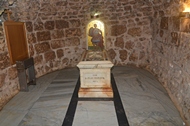
- John 1:44: “Now Philip was of Bethsaida, the city of Andrew and Peter”.
- According to the New Testament, BethSaida was known as the birthplace of the Apostles Andrew, Peter, and Philip. A fisherman’s house was excavated in Bethsaida – perhaps Peter’s house?
An alternative location for Bethsaida, on the shore of the Sea of Galilee. A Byzantine church of the Apostles was recently excavated on the site, with a mosaic inscription referring to Peter. “…Chief of the apostles and keeper of the keys of the heavenlier”.
Etymology (behind the name):
- Simon Bar-Yonah – Yonah, Jonah, Jona – Hebrew: “Dove”.
Simon – Hebrew: Shimon, meaning: “He hears (God’s words)”. In the Old Testament, Shimon was the second son of Jacob and Leah. His descendants were nomads, living in the southern part of Judah.
Bar – Aramaic: “Son”. This was a common prefix to the family name, named after the father.
- Peter – Jesus give his Apostle, Simon Bar-Yonah, the nickname ‘Peter’ – meaning rock (Petros) in Greek (John 1 42): “And he brought him to Jesus. And when Jesus beheld him, he said, Thou art Simon the son of Jona: thou shalt be called Cephas, which is by interpretation, A stone”.
- Cephas – Aramaic for “rock” or “stone”
Links:
* External:
*Internal:
BibleWalks.com – Have Bible, will travel
Barak & Deborah <<<—Previous info—<<< All Info >>>—Next Info—>>> Jesus
This page was last updated on Feb 7, 2025 (add El Araj, Rome)
Sponsored links:
